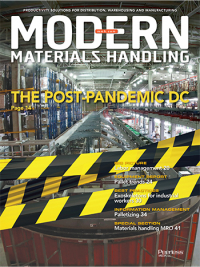Ergonomics and pandemics: Softening the (really big) bumps
Operator comfort is paramount in efforts to retain employees and maintain productivity.
It’s a fair question: How can you talk about lift truck ergonomics when people are struggling to get shipments out the door? Joe Tomkiewicz, director of industry strategy for Yale Materials Handling Corp., suggests the discussion is essential to keep employees from going out the door.
“Now more than ever, operators are tasked with doing as much as possible, as safe as possible and comfortable as possible so they’ll come back the next day,” Tomkiewicz says. “When you’re application-focused and your dealer understands your business and what you’re trying to accomplish, often ergonomics and safety come to the forefront.”
Nearly all lift trucks now come standard with features that promote safety and ergonomics as a baseline. The reality, Tomkiewicz says, is that customer facilities have to adjust to meet changing conditions. This can result in irregularities around pedestrian and equipment traffic patterns and environmental conditions, which could change what’s needed from an ergonomic perspective.
“That powered industrial truck is an operator’s office, but I look at them as athletes,” Tomkiewicz says. Office workers will tell you not all chairs are the same, and runners can be particular about their shoes. “An end-rider’s operator platform doesn’t stand out to you or me, but for the operator who’s there for the better part of an eight-hour shift, it’s absolutely critical.”
While a basic rubber mat helps to absorb shock and vibration, more sophisticated “smart ride” systems can reduce up to 65% of shocks and vibrations to the operator’s feet, back and legs. Equipment designed to make it easier to get on and off is nice, but voice technology can cut down on the need to mount and dismount from certain lift truck models in the first place. Tomkiewicz says voice-enabled operators can become up to 20% more productive.
Tomkiewicz describes recent innovations in posture relief for side-stance reach trucks. The design enables operators to travel and operate in a leaning position, offering mobility somewhere between standing and sitting that is especially useful for making longer runs.
Lighting is another increasingly popular feature because it can improve operator and pedestrian awareness while boosting productivity. An end-rider going into a dimly lit trailer has an advantage if equipped with lights to help easily identify pallet positions instead of relying on dock lights that can be broken, manhandled or simply not used.
Similarly, Tomkiewicz says camera system installations have spiked, both at the time of lift truck production and in the aftermarket. As facilities get taller and taller, a fork-level view of pallet openings can help keep operators productive at height. “For lift truck drivers, that piece of equipment is their livelihood—and the company’s livelihood,” he says. “You have to design accordingly.”

Article Topics
Lift Truck Tips News & Resources
Overlooked no more: The importance of lift truck inspections Lithium transition: It’s all about the outcomes Safety for automatic guided vehicle (AGV) environments Assessing the move to lithium Leasing’s fleet management upside Managing for lift truck operator safety Narrow aisle success: Think systems, then trucks More Lift Truck TipsLatest in Materials Handling
Geek+ and System Teknik deploy PopPick solution for pharmacy group Med24.dk Beckhoff USA opens new office in Austin, Texas Manhattan Associates selects TeamViewer as partner for warehouse vision picking ASME Foundation wins grant for technical workforce development The (Not So) Secret Weapons: How Key Cabinets and Asset Management Lockers Are Changing Supply Chain Operations MODEX C-Suite Interview with Harold Vanasse: The perfect blend of automation and sustainability Consultant and industry leader John M. Hill passes on at age 86 More Materials HandlingAbout the Author
Subscribe to Materials Handling Magazine

Find out what the world's most innovative companies are doing to improve productivity in their plants and distribution centers.
Start your FREE subscription today.
April 2024 Modern Materials Handling

Latest Resources












